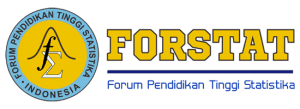PENDEKATAN MODEL VECTOR AUTOREGRESSIVE (VAR) UNTUK MERAMALKAN FAKTOR-FAKTOR YANG MEMPENGARUHI INFLASI DI PROVINSI GORONTALO
Abstract
The vector autoregressive (VAR) model is a simultaneous equation modeling used to construct forecasting systems from interrelated time-series data. This study intends to predict factors that significantly influence inflation in the province of Gorontalo. Moreover, the data used in this study involved inflation data and factors that influence inflation every month in the province in the period of January 2009 - December 2018. The results of inflation forecasting in Gorontalo in 2019 show that at the beginning of 2019, the inflation was considered to be very low at around -0.48% to -0.40%. However, the inflation surged in March with -0.25% (the highest inflation rate). The percentage decreased to -0.30% and -0.33% in April and May. After the decline in April and May, in the middle of the year (June) inflation returned to -0.31% and did not experience a significant change until the end of the year, which was still in the range of -0.32%. The accuracy of the prediction results seen in the MAPE value from out sample data of variables Y1 to Y8 is on the average below 10%, indicating that VAR is a significant forecasting model.
Keywords
Full Text:
PDFReferences
BPS. (2018), "Indeks harga Konsumen dan Inflasi" Available athttps://gorontalo.bps.go.id/subject/3/inflasi.html#subjekViewTab3.
Desvina, A. P., and Juliana, M. (2016), "Pemodelan Pencemaran Udara Menggunakan Metode Vector Autoregressive(VAR) di Provinsi Riau" SiTekIn: Jurnal Sains dan Teknologi, 13, 160-167. http://dx.doi.org/10.24014/sitekin.v13i2.1669.
Ekananda, M. (2016), Analisis Ekonometrika Dan Analisis Time Series, Jakarta: Mitra Wacana Media.
Hardani, P. R., Hoyyi, A., and Sudarno, S. (2016), "Peramalan Laju Inflasi,Suku Bunga Indonesia dan Indeks Harga Saham Gabungan menggunakan Metode Vector Autoregressive (VAR)" Jurnal Gaussian, 6, 101-110.
Hendajany, N. (2015), "Tingkat Inflasi Suku Bunga Bank Indonesia Jumlah Uang Beredar dan Kurs" Eko-Regional: Jurnal Pembangunan Ekonomi Wilayah, 10, 39-47. https://doi.org/10.20884/1.erjpe.2015.10.1.756.
Ohyver, M. (2013), "Penerapan Metode Transpormasi Logaritma Natural dan Partial Least Square untuk memperoleh Model Bebas Multikoliner dan Outlier" Jurnal Mat Stat, 13, 42-51.
Prahutama, A., Suparti, S., Ispriyanti, D., and Utami, T. W. (2019), "Modelling Inflation Sectors in Indonesia Using Vector Autoregressive (VAR)" Jurnal ILMU DASAR, 20, 47. https://doi.org/10.19184/jid.v20i1.7259.
Suhel, S. (2008), "Analisis Model Vector Auto Regression (VAR) Terhadap Hubungan Antara Pertumbuhan Ekonomi Dengan Penanaman Modal Asing (PMA) di Indonesia" Jurnal Ekonomi Pembangunan, 6, 96-113. https://doi.org/10.29259/jep.v6i2.4855.
Supranto, J. (2005), Ekonometrika Buku Kesatu, Bogor: Ghalia Indonesia.
DOI: https://doi.org/10.34312/jjps.v1i1.5408
Refbacks
- There are currently no refbacks.
Copyright (c) 2020 Jambura Journal of Probability and Statistics

This work is licensed under a Creative Commons Attribution-NonCommercial 4.0 International License.







.jpg)






